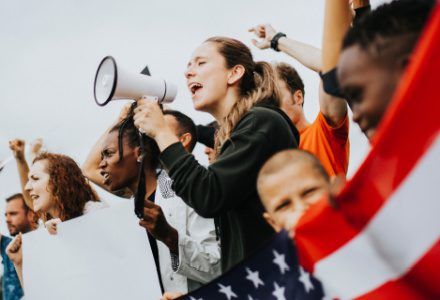When Does Someone’s Abusing Drugs Justify The Loss of Second Amendment Rights?
It is reasonable to believe that people should not carry a loaded firearm in public when they are intoxicated. But whether the government can or should prohibit an individual from even possessing a firearm because the individual uses or is addicted to illegal drugs is a different question. Federal law (Section 922(g)(3)) expressly prohibits (and criminalizes) the possession of a firearm by an individual who unlawfully uses or is “addicted” to certain illegal drugs. Further, an individual purchasing a firearm from a licensed firearm dealer must affirm on the federal disclosure form that he or she is not a user nor “addicted” to illegal drugs. Violating Section 922(g)(3) or lying on the federal disclosure form can result in significant criminal penalties.
A superficial glance at this issue suggests the lack of any reasonable dispute that “drug addicts” should not possess firearms. The issue, however, is not as simple as a policy matter nor as an issue of constitutional law. Addiction is a lifelong struggle, even after an individual stops using drugs. For a recovering addict the reuse of drugs could very well trigger a relapse into the uncontrolled use of drugs. There are a vast number of recovered addicts in the United States, however, who will never use drugs again, and federal law should not prohibit these people from possessing a firearm because of a problem in their past that they overcame. The difficulty with the word “addict,” is that it can include people who are actively using drugs and those who are not.
Federal law, however, does not simply target addicts. Section 922(g)(3) also prohibits the possession of firearms by individuals who unlawfully use illegal drugs. There is considerable ambiguity as to what level of illegal drug use triggers Section 922(g)(3). Marijuana, for example, is a controlled substance, and many Americans would be swept within Section 922(g)(3)’s scope if the sporadic use of marijuana made them “users” of illegal drugs under Section 922(g)(3).
While policy concerns and vagueness issues are important, for this article, the question is whether the Second Amendment protects the right of all or some “addicts” to possess a firearm, and when or if the “use” of illegal drugs is sufficient to allow the government to strip an individual of his or her Second Amendment rights. The United States Court of Appeals for the Seventh Circuit recently addressed this issue in U.S. v. Seiwert.
In Seiwert, the defendant was addicted to drugs and used heroin and/or crack cocaine on a daily basis for 20 years. The defendant (Mr. Seiwert) inherited a large number of firearms when his father passed away. Law enforcement was apparently investigating Mr. Seiwert’s drug dealer, and during that investigation, obtained incriminating information about Mr. Seiwert. The government asserted that Mr. Seiwert had given his drug dealer two handguns in exchange for drugs. The government obtained a warrant to search Mr. Seiwert’s home and found “two digital scales, a wooden pipe, a glass pipe, and a triple beam balance scale.” Law enforcement also found approximately 100 firearms.
When the police questioned Mr. Seiwert, he admitted having drugs at his home and that he had used crack cocaine earlier in the day. He also volunteered that he had “used heroin and crack cocaine every day for twenty years and that he was a ‘functioning drug addict.’” Mr. Seiwert also “estimated that he had purchased drugs from German [his drug dealer] over 300 times since November of the previous year.”
Mr. Seiwert was charged under 18 U.S.C. Section 922(g)(3) for having possession of two handguns (that he sold to his drug dealer for drugs) when he was addicted to drugs and was an unlawful user of illegal drugs. Mr. Seiwert moved to have the charges against him dismissed on the ground that Section 922(g)(3) was unconstitutional under the Second Amendment. The lower district court denied Mr. Seiwert’s motion, and Mr. Seiwert was convicted after a trial. The Seventh Circuit Court of Appeals rejected Mr. Seiwert’s Second Amendment challenge and affirmed his conviction.
The Seventh Circuit applied the two-part test created by the Supreme Court in the Bruen decision for analyzing Second Amendment claims: (a) does the statute appear on its face to infringe the right to keep and bear arms, and (b) is the statute supported by a historical legislative tradition that existed when the Second Amendment was enacted. Mr. Seiwert had the burden of proving that Section 922(g)(3) created an apparent infringement on his right to keep and bear arms. In Seiwert, the Seventh Circuit had little trouble concluding that a complete prohibition on the possession of firearms by Mr. Seiwert constituted an apparent infringement of his Second Amendment rights.
An apparent infringement, however, is not the end of the analysis. The government then had the opportunity to prove that Section 922(g)(3) did not create an actual “infringement” under the Second Amendment by showing the existence of a historical legislative tradition that allowed the seizure of firearms in analogous situations. The reasoning behind this test is that a legislative tradition allowing the seizure of firearms that existed when the Second Amendment was enacted demonstrates that the framers of the Second Amendment would have understood that these laws reflected a limitation on the right to keep and bear arms. Put differently, the Second Amendment incorporates the laws regulating the possession and use of firearms that were in place when the Second Amendment was enacted. This provides some contours and limits on the Second Amendment’s scope and takes from the courts the ability to simply make public policy decisions under the guise of constitutional analysis.
The difficulty is determining whether a current law falls within a historical legislative tradition that allowed for the seizure of firearms or a prohibition on the possession of firearms. The Supreme Court has stated that the historical legislative tradition does not have to be a dead ringer for the modern law being challenged. The modern law, however, must be “analogous” in a meaningful way to a relevant historical tradition. This means that the modern law must regulate a societal problem in a way similar to the way the societal issue was addressed by laws in place around the time the Second Amendment was enacted. The Supreme Court in Bruen phrased this analysis as the “how” and “why” tests. The “how” test asks whether the two sets of laws being compared address the relevant societal problem in an analogous way. The “why” test looks at whether the two sets of laws address a similar societal problem.
In Seiwert, the Seventh Circuit based its holding on two sets of historic laws: (a) public intoxication laws, and (b) laws concerning individuals who are mentally ill. The Court’s reliance on 18th-century public intoxication laws was misplaced. The court’s reliance on laws in place around the time the Second Amendment was enacted that addressed mental illness is a better, but not a solid, fit. While a good-faith argument can be made that the earlier mental health laws can, in some cases, justify the seizure of firearms from chronic drug users, this fit will only reasonably allow the seizure of firearms in a narrow category of cases.
- Public Intoxication Laws
The excessive use of alcohol and drugs was a problem that existed when the Second Amendment was enacted. The absence of laws specifically allowing for the disarming of persons who abuse drugs or alcohol is a strong indication that defending Section 922(g)(3)’s prohibitions on the possession of firearms is an uphill battle under the Second Amendment. The difficulty for the court was that, before and after the Second Amendment was enacted, the laws addressing firearms and intoxication had a narrow focus and did not come close to imposing a general prohibition on the possession of firearms.
While courts can use analogical reasoning to compare a current law with historical laws, it is improper to use analogy as a cover to create policy. A case like Seiwert is challenging because Mr. Seiwert is not a sympathetic defendant. But hard cases can result in bad decisions that erode constitutional rights.
The intoxication laws on which the Seventh Circuit relied do not support Section 922(g)(3). For example, the Seventh Circuit identified some Massachusetts laws and a New Jersey law that allowed the police to arrest drunks who “endangered others.” The New Jersey law only allowed the police to arrest and hold the individual until he or she was sober. The New Jersey law was also limited to drunks who were “unruly and disturbers of the peace.” These laws fail the “how” and the “why” parts of the historical legislative tradition test. These laws did not authorize the police to seize an individual’s firearms from their home and prohibit the individual from acquiring any new firearms. Indeed, it does not appear that these laws addressed the seizure of firearms at all. With respect to the “why” analysis, these laws addressed public intoxication and resulting disorderly behavior. Section 922(g)(3) does not require any type of violent or disorderly conduct by a user of illegal drugs, nor does it require any showing of public intoxication. The laws cited by the Seventh Circuit support, in fact, the position that the abuse of alcohol and drugs was not a legitimate basis for seizing someone’s firearms.
The Seventh Circuit then identified laws from New Hampshire and Indiana that allowed for the apprehension of drunks. The Indiana law was limited to drunks who were “noisy in public,” and only allowed their confinement for 48 hours. These laws are not at all analogous to Section 922(g)(3), which makes the possession of any firearms by a user of drugs or an addict unlawful. At best, these laws were designed to keep drunks in a residence and off the streets, or, at a minimum, keep them from being noisy. If laws preventing disorderly conduct by drunks, with no mention of seizing firearms, are deemed equivalent to laws completely disarming individuals, the Bruen test does not actually mean much.
The Seventh Circuit then cited a number of laws that allowed the imprisonment, for set periods of time, of drunks unless they provided security for good behavior. The court stated that these laws only “disarmed” individuals while they were imprisoned. This does not provide any support for the constitutionality of Section 922(g)(3). First, these laws did not apparently allow the police to go to an individual’s home and seize their firearms. Second, these laws did not prohibit these individuals from possessing firearms after they were released from custody. The laws themselves did not call for the seizure of the individual’s firearms. While the individual would presumably have had his firearm taken as part of the process of incarceration, that is a different issue altogether (not letting inmates have firearms while incarcerated). Not letting incarcerated individuals possess firearms while incarcerated is not controversial, and addresses a different societal issue than intoxicated persons having firearms. Laws addressing conditions of confinement have nothing to do with how modern legislation can treat people who are not incarcerated.
The court then points to a Virginia law from 1656 that made it unlawful for drunks to discharge their firearms at drinking events in order to preserve gunpowder. The court does not say that this law allowed for the disarming of these individuals, and admits the law was designed (the “why”) to preserve gunpowder stocks. A law that predates the enactment of the Second Amendment by over 100 years and addresses a very different and narrow societal issue peculiar to an early colony cannot support Section 922(g)(3).
The court then cited a Rhode Island law from 1731 that “barred using firearms in taverns after dark.” This law obviously fails both the how and the why tests. The court then doubles down with a New York law that prohibited discharging firearms “during the New Year’s holiday.” This law was designed to prevent damage to property by drunks firing their guns in public. This law also fails the how and why tests. The law prohibited discharging a firearm; it did not criminalize being intoxicated or even carrying a firearm when intoxicated.
The court next turns to laws concerning the punishment of militiamen who were intoxicated while on duty. The court recognized that these laws had “limited” value for assessing the constitutionality of Section 922(g)(3). It is doubtful that laws addressing questions of military discipline and readiness have any bearing on the constitutionality of Section 922(g)(3).
The court then finally turned to a number of laws, many enacted long after the Second Amendment was enacted, that made it unlawful to carry a firearm in public while intoxicated. These laws also fail the how and why tests. The initial implication from these laws is that it was lawful to have a firearm in your home even if you were intoxicated. Further, these laws did not apparently ban the possession of firearms by an individual who violated the law. These laws made it unlawful to leave your home with a firearm or to get intoxicated while carrying a firearm. These laws say nothing about being in possession of firearms in your home while you are intoxicated. Ironically, these laws were designed to force intoxicated people, or people who planned to get intoxicated, to keep their firearms at home. There is no indication that these laws allowed for the general seizure of firearms or the complete disarming of that individual.
The overall problem with the court’s reliance on the intoxication laws is that these laws did not prohibit the possession of firearms by drunks or chronic abusers of alcohol or drugs. Given that the abuse of alcohol and drugs during the late 1700s and early 1800s was a societal problem, the lack of any laws prohibiting the possession of firearms by persons who abused alcohol cuts strongly against an argument that these laws can support the prohibition contained in Section 922(g)(3). The laws cited by the court were narrowly drafted to address the problem of public intoxication and disorderly conduct while intoxicated, but were not focused on disarming these individuals.
- Mental Illness Laws
The Court stood on stronger ground when it turned to laws that address the treatment of mentally ill individuals by early American laws. The laws cited by the court were sparse, but they recognized that mentally ill individuals can pose a danger to themselves and others. The court also pointed to a number of laws from the late 1800s that expressly prohibited the sale of firearms to mentally ill individuals. While these laws are not directly on point, they provide some support for the claim that current and active users of powerful illegal drugs should not have access to firearms. First, the Supreme Court recognized in Rahimi that a documented finding that an individual poses a real threat to others is a basis for disarming that individual for a limited period of time. Second, it is well recognized that the use of modern illegal drugs can result in temporary or possibly permanent psychosis and other types of mental health breakdowns. The recognition in early American law that mental illness could make an individual particularly dangerous in some cases provides some support for the claim that the current and extreme abuse of dangerous illegal drugs can justify the seizure of an individual’s firearms.
While the historical legislative tradition concerning mental illness provides some support for Section 922(g)(3), it also places significant constitutional limitations on when the government can disarm an individual under Section 922(g)(3). The facts in Seiwert were egregious. Mr. Seiwert used heroin and crack cocaine daily for at least 20 years, admitted to using crack cocaine on the day he was arrested, and gave two handguns to a drug dealer for drugs. Concluding that Mr. Seiwert’s drug use made him a danger to others was not an unreasonable conclusion. Considerable doubt remains, however, as to the constitutionality of applying Section 922(g)(3) to occasional drug users, or those who have not used illegal drugs for some period of time. Further, the Seventh Circuit’s decision is extremely narrow, given Mr. Seiwert’s considerable drug use. This is a new area of Second Amendment law that is going to take some time to get worked out by the courts.
Previous Post
When Is Someone Too Dangerous To Have a Firearm (The Slippery Slope and The Second Amendment)
A constitutional right means little if government officials have the discretion to suspend or ignore that right. Constitutional rights limit what government officials can...
NEXT Post
When Does Someone’s Abusing Drugs Justify The Loss of Second Amendment Rights?
It is reasonable to believe that people should not carry a loaded firearm in public when they are intoxicated. But whether the government can...







